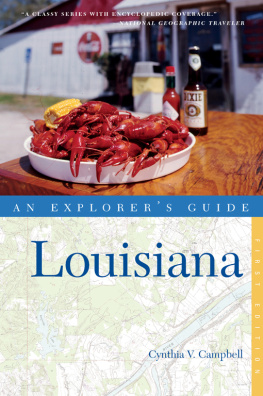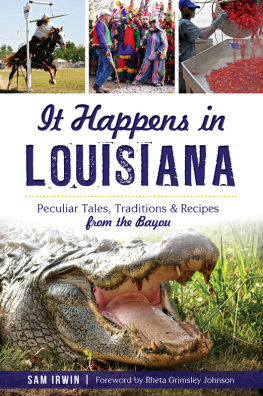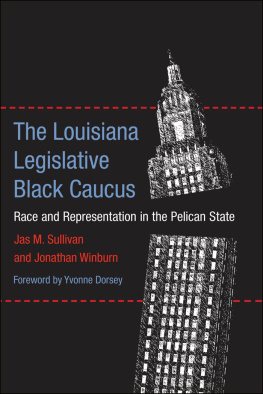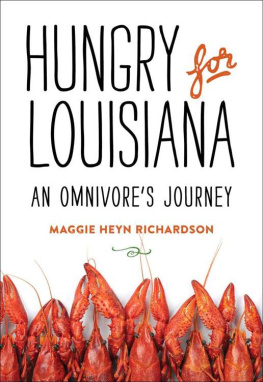The
LOUISIANA
FIELD GUIDE
The
LOUISIANA
FIELD GUIDE
UNDERSTANDING LIFE IN THE PELICAN STATE
EDITED BY
RYAN ORGERA & WAYNE PARENT

LOUISIANA STATE UNIVERSITY PRESS
BATON ROUGE
Published by Louisiana State University Press
Copyright 2014 by Louisiana State University Press
All rights reserved
Manufactured in the United States of America
First printing
Designer: Barbara Neely Bourgoyne
Typefaces: Brandon Printed, display; Whitman, text
Printer and binder: Maple Press
LIBRARY OF CONGRESS CATALOGING-IN-PUBLICATION DATA
The Louisiana field guide : understanding life in the Pelican State / edited by Ryan Orgera and Wayne Parent.
pages cm
Includes bibliographical references and index.
ISBN 978-0-8071-5776-3 (cloth : alkaline paper) ISBN 978-0-8071-5777-0 (pdf) ISBN 978-0-8071-5778-7 (epub) ISBN 978-0-8071-5779-4 (mobi) 1. Louisiana. I. Orgera, Ryan, 1983 II. Parent, Wayne, 1955
F369.L8845 2014
976.3dc23
2014005846
The paper in this book meets the guidelines for permanence and durability of the Committee on Production Guidelines for Book Longevity of the Council on Library Resources.

For Melli
&
For the Luquette, Parent, Rivire, and Windom families;
thank you for making me part of your Louisianas.
RO
For my brothers Dale and Randy:
theyre as awesome as the state we love.
WP
CONTENTS
Preface
Ryan Orgera
The Geography of Louisiana
Kent Mathewson
The Tie That Binds: Louisianas Natural Riches
A. Raynie Harlan and David P. Harlan
Louisiana History
Alecia P. Long
Louisiana Cultures: A Creole Mosaic
Joyce Marie Jackson
Love Vine and Lived Religion in Louisiana
Michael Pasquier
Louisiane/Louzyann/Luisiana/Louisiana
Ryan Orgera
Les Cadiens
Aaron C. Emmitte
Creole French in Louisiana/Kreyl Andan La Louzyann
Thomas A. Klingler
Cajun Vernacular English
Sylvie Dubois
Literary Carnival and the Dream State
Karen Williams
The Local Diet
Maggie Heyn Richardson
Louisiana Politics: Populism, Reform, and Disaster
Wayne Parent
How Did We End Up at This Party?A Feral Louisiana Playlist
Alex V. Cook
Authenticity as a Conundrum in Eight Louisiana Films
Zack Godshall
The Architecture of Louisiana
J. Michael Desmond
Louisiana as Center for the Arts
Richard Anthony Lewis
LSU Football and Other Sports in Louisiana
Barry C. Cowan
PREFACE
RYAN ORGERA
As Wayne and I discussed the idea that would become this volume, we knew we did not want to produce another book about Louisiana that pined for yore. Rather, it had to be a timely collection that was both organic and ordered; creative and succinct; and above all honest. Our goal remains a pertinent exploration of a multifaceted Louisiana written by local experts who recognize that we have so much to celebrate and to experience here. The Louisiana Field Guide offers portraits of the state that challenge, reaffirm, and elucidate for locals, newcomers, and visitors alike.
Our state is one that enjoys a larger-than-life image. Even outside of its borders, the word Louisiana conjures images of thrown beads, king cakes, hurricanes, corruption, and bayous. Louisiana was the eighteenth state admitted to the Union, yet despite its long history as part of the United States, it has retained much of its singularity. Its histories are often framed by French, Spanish, or English colonial struggles; its politics is peppered with their vestiges; its cultures live and re-create their traditions; and its languages are part of this flux. We have rich and painful connections to West Africa and to pre-European peoples, and they, too, create our contemporary Louisiana. Louisianians celebrate the past like no others. Tradition thrives in every jambalaya pot, on the street signs of Breaux Bridge, and on the farmland of East Carroll Parish. Louisiana is a land where we rejoice in our roots in churches, jazz clubs, and Tiger Stadium. For hundreds of years, we have celebrated Mardi Gras and lit fires on the levees for Christmas Eve, and at times when celebration seemed futile or impossible, we have found a way to use our traditions as a means to move forward. Our blithe spirit is not how we mask our travails; it is how we remake and express our histories. Heritage is our grandest asset.
These ways of life unfurl over a land and shore equally singular. Few places have such a bewitching landscape as Louisiana. While we do not boast the mountain vistas of Wyoming or the long, sandy stretches of Florida, we do have spaces and places that inspire a feeling distinctly Louisianian. From the marshes, that pseudo-land between the Gulf of Mexicos waters and more solid soils; to the Atchafalaya Basin, a great carved mass of trees, water, bears, and birds; to the loblolly pinescapes of west and north Louisiana, this state is truly a natural wonder. The often close, small-sky vistas of south Louisiana are marked by ancient, gnarled live oaks that sprouted before the arrival of the first Europeans. In crowded cypress groves, arrow-straight trees filter sunlight amid the profound stillness, interrupted only by a passing heron or the slink of a turtle into our ubiquitous waters. Our landscapes are the products of ancient struggle and process, of primordial geologic and hydrologic movements; they set the stage for a people marked by ancient and concurrent forces.
There is an ineffable quality here, one for which words often fall short to describe the essence of our landscapes, traditions, shared spirit. Our origins, be they Angolan, French, Spanish, or Vietnamese, have rubbed against each other and melded. While we could easily focus on the tragedies that have befallen our state, we have chosen instead in this volume to celebrate how Louisiana expresses itself, be it an expression born from pain or complexity, joy or necessity. The expressions herein pay homage to the curious, the unique, and the unheard in us all. Enjoy this collection, as it represents parts of all of those who truly have known this Pelican State.
ACKNOWLEDGMENTS
This volume is a collaboration, and we appreciate the good work of all the individual authors and the lasting friends we have made in the process. We would also like to acknowledge the efforts of Dustin Howes, whose photos appear in several essays. Dustins good eye, technical skills, and willingness to meet our needs added joy and real value to this undertaking. Gabe Giffin, who also contributed a photo, worked with us from the beginning, formulating ideas and keeping us enthused. Gabe played an important supportive role throughout. Finally, we would like to thank Andrew Joyner for his contribution of cartography and ideas throughout this process.
The
LOUISIANA
FIELD GUIDE
SHAPING LOUISIANA
OUR GEOGRAPHY AND ENVIRONMENT

THE GEOGRAPHY OF LOUISIANA
KENT MATHEWSON
At a time when some argue that globalization is making the world flat, through hyper-connectivity and declining cultural diversity, one of geographys main concepts and building blocksregionsremains a useful way to put people, places, and landscapes in perspective. Topographically speaking, Louisiana may be largely flat, but its diverse peoples, places, and landscapes form a number of regions that are far from featureless. As other essays in this volume make abundantly clear, Louisiana is a placeif not quite a worldapart. Yet, Louisiana shares in larger physical and human geographical patterns that belie complete uniqueness. The states distinctive geographical traits are best seen and understood within the web of these larger connections. Geography has often been cast as the stage upon which History performs. In the case of Louisiana, its diverse geographies can be seen as the play itself, with history in a supporting role. Geography provides the regional construct to understand differences between places, landscapes, and areas. Louisiana viewed through its regions and their characteristics allows for clear demarcation of its many familiar particularities as well as indications of less recognized similarities with other places or regions.
Next page









